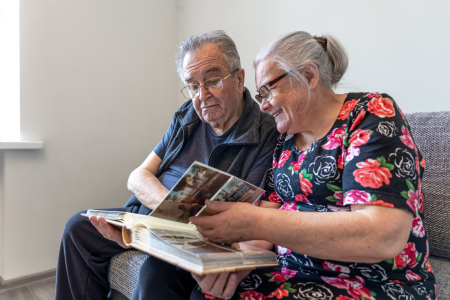Elderly people in the Republic of Moldova in 20241
On the occasion of the International Day of Older Persons, marked annually on October 1, the National Bureau of Statistics presents information on the situation of the elderly, according to available data for 2024.
Demographic situation
In the Republic of Moldova, at the beginning of 2025, there were 616.5 thousand persons[2] aged 60 and over, which constitutes 25.9% of the total population with usual residence. At the beginning of 2025, the population aging coefficient[3] accounted for 25.9%, which corresponds to a high level of demographic aging. On January 1, 2025, the ratio of men to women aged 60 and over accounted for 66.0 men per 100 women. The average life expectancy of the population aged 60, in the period 2020-2024, increased by 1.7 years for men and by 2.0 years for women. The main causes of mortality in the elderly were diseases of the circulatory system (65.0% of all deaths in this age group), tumors (17.0%) and diseases of the digestive system (6.2%).
Health status
According to data from the National Agency for Public Health, in 2024, 11.2 thousand cases of malignant tumors were recorded, about 74.0% of which were in people aged 60 and over. Malignant tumors are more common in men, with an average of 1800 new cases of malignant tumors per 100 thousand men aged 60 and over, compared to 1062 new cases per 100 thousand women of that age. In 2024, at the national level, 1.3 thousand new cases of active tuberculosis were recorded, with every fourth case (24.5%) occurring in a person aged 55 and over. Those most affected by active tuberculosis are men aged 55-64.
Disability among older persons
According to data from the National Council for Determining Disability and Work Capacity, in 2024, following the primary examination, 10.7 thousand adults were recognized with primary disability, including 0.7 thousand women aged 60 and over and 0.4 thousand men aged 63 and over. The causes that most often determined primary disability in the elderly were diseases of the circulatory system (30.4%), followed by malignant tumors (16.4%) and diseases of the osteo-articular system, muscles and connective tissue – 11.8%.
Social protection
According to the data of the National Social Insurance House, as of January 1, 2025, the total number of pensioners[4] amounted to 672.7 thousand people, of which 78.7% of the total number of pensioners were old-age pensioners. The average size of the old-age pension in 2024 amounted to 3983.9 lei, increasing by 8.2% compared to the previous year, and compared to the beginning of 2021, it increased by 92.7%. The amount of the minimum old-age pension, as of 01.01.2025, amounted to 2777.9 lei and covered the minimum subsistence level for pensioners by 12.3%. At the same time, about 24.2% of old-age pensioners were employed at the time of pension establishment.
Labor market
According to the Labor Force Survey, in 2024 the number of economically active elderly people (aged 60 and over) amounted to 98.2 thousand people, an increase of 1.2% compared to 2023. In 2024, the employed population aged 60 and over amounted to 96.3 thousand people, which represents 11.3% of the total employed population Every fifth employed elderly person worked in agricultural activities. Thus, 24.5% of men worked in the agricultural sector, 15.4% - in industry and 11.1% - in trade, and 21.4% of elderly women were employed in education, 19.5% - in health and social assistance and 18.3% - in agriculture. Of the total households consisting only of elderly people, 64.0% lived in rural areas and, respectively, 36.0% in urban areas. In the distribution of the elderly population by professional status, the vast majority are employees (81.0%), followed by self-employed workers (15.2%).
Living standards of households with elderly people
According to the Household Budget Survey, in 2024, 44.6% of all households had at least one person aged 60 and over, of which 75.3% were households made up only of elderly people, and the rest of the households also had other people. Of all households made up only of elderly people, 64.0% lived in rural areas and, respectively, 36.0% in urban areas. The income of households with elderly people is determined by several factors, on average, they had 4898.2 lei per person per month. The main source of income of households with elderly people was social benefits, which constituted 51.8% of the monthly income of the household. The expenditures of households with elderly people were mainly intended for food consumption (46.3%), followed by expenditures for housing and communal services – 20.4%, clothing and footwear – 5.8%, health – 5.7%. Of the total households consisting only of elderly people, 78.6% assessed their standard of living as satisfactory, 6.7% – good or very good, and 14.6% declared their household standard of living as bad or very bad.
More detailed information is available in Romanian language.
Notes:
[1] The information is presented without data on the population of the localities on the left bank of the Nistru River and the municipality of Bender, except for data from the Disability of the elderly section, which also includes people from the left bank of the Nistru River and the municipality of Bender, who applied for disability certification.
[2] The data on the population with usual residence as of January 1, 2024 and 2025 are provisional. The population number, as well as the relative indicators dependent on the population number, are reported to the population with usual residence, calculated based on the 2014 population and housing census.
The usual residence is defined as the place where the person has lived predominantly in the last 12 months, regardless of temporary absences (for the purpose of recreation, vacation, visits to relatives and friends, business, medical treatment, religious pilgrimages, etc.).
Methodological clarifications:
[3]Population aging coefficient – the number of people aged 60 and over per 100 inhabitants.
[4]The number of pensioners includes persons whose pensions have been established in accordance with Law 156/1998 on the public pension system and Law 1544/1993 on pension insurance for military personnel and personnel from the command corps and troops of internal affairs bodies. Starting with 01.01.2017, pensioners employed by law enforcement bodies are included in the total number of pensioners, being registered with the National Office for Social Insurance.
- Nadejda CojocariHead of Division
Social Services Statistics Division
- Report a mistake. Select the desired text and press CTRL + ENTER






